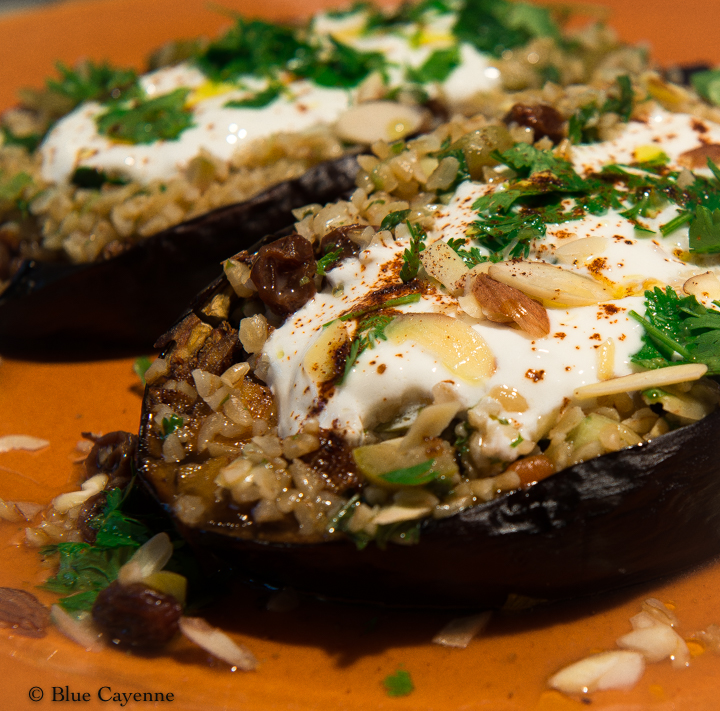Which “vegetable” is actually a berry, has the highest nicotine content among all vegetables, and is 95% water? (Hint: Chinese ladies once used the dye extracted from this vegetable’s skin to polish their teeth to a then-fashionable gray hue.)
It’s the eggplant. Who knew? (Don’t worry about the nicotine part, by the way. You would have to consume 20 pounds of eggplant to get the amount of nicotine in a single cigarette. That is more eggplant than even eurysome Chris Christie could eat in one sitting.)
Also called a brinjal (India), a melanzana (Italy) and an aubergine (France), the eggplant is a member of the nightshade family that includes tomatoes and potatoes. Native to Asia, the eggplant was introduced into Europe via Mediterranean trade. Thomas Jefferson is credited with introducing the eggplant to American tables and grew plants in his Virginia garden.
Historically, the reputation of the eggplant is a mix. On the one hand, there is a charming Japanese proverb that enthuses about dreaming of eggplant on New Year’s Eve: “The happiest omen for a new year is first Mt. Fuji, then the falcon, and lastly eggplant.” (I’m trying to imagine the storyline of such a dream. It might go something like this… With a cloud-shrouded Mt.Fuji looming majestically in the background, a solitary falcon soars soundlessly above the landscape. Suddenly, spotting its prey, the falcon stops mid-air and then swoops from the sky, only to find that he has targeted a single purple eggplant. Bummer for the falcon. No! Wait! The curious falcon notices that the eggplant is glowing–an enchanted orb. Then, before the world-weary falcon’s eyes, the eggplant transforms into a lovely purple-gowned princess. The princess promptly falls in love with the lonely falcon and bestows upon him a single magical kiss whereupon the falcon morphs into a handsome Japanese prince. And today, if you look ever so carefully, you can see them– two lovers standing in luxuriant fields of eggplants growing on the slopes of Mt. Fuji and pondering their good fortune in life. The prince is now a wealthy anime mogul and the princess operates an elegant ryokan named L’aubergine. <cue the music>)
On the other hand, Medieval Europeans were wary of consuming eggplant, believing it was a poison that could cause madness. (The Italian word for eggplant is a variation on the term mad apple.)
The high season for eggplants is August to October, so you will find an abundance of eggplants (there are more than twenty varieties) in markets at the moment, and this recipe, adapted from Ottolenghi’s well-regarded cookbook Jerusalem, is both a delicious and beautiful way to ease into eggplant season.
Wishing you handsome princes and eggplant dreams.
Yields 4 Servings
1 hr, 30 Total Time
Ingredients
- 2 cloves garlic (crushed)
- 2 t. ground cumin
- 2 t. ground coriander
- 1 t. chili flakes
- 1 t. sweet paprika
- 2 T. finely-chopped preserved lemon peel (I used 1 t. lemon zest)
- 2/3 C. olive oil
- 2 medium eggplants
- 1 C. fine bulgur (I used coarse)
- 2/3 C. boiling water
- 1/2 C. golden raisins (or more to your taste)
- 3 1/2 T. warm water
- 2 t. cilantro (chopped)
- 2 t. mint (chopped)
- 1/3 C. pitted green olives (roughly chopped or halved)
- 1/3 C. sliced almonds (toasted)
- 3 green onions (chopped)
- 1 1/2 T. freshly squeezed lemon juice
- 1/2 C. Greek yogurt
- Salt
- Feta (crumbled) to garnish
- Pinenuts (toasted) to garnish
- Chopped cilantro to garnish
- A drizzle of good quality olive oil
Instructions
- Preheat oven to 400 degrees F.
- Chermoula: Mix garlic, cumin, coriander, chili, paprika, lemon, 2/3 of the olive oil, and 1/2 t. salt in a bowl and set aside.
- Cut eggplants in half lengthwise. Score the flesh of the eggplants and spoon chermoula sauce over each half, spreading evenly. With the cut side facing up, place eggplants on a baking sheet and roast the eggplant in the oven for about 40 minutes. (The eggplants should be totally soft when they are done.)
- Put the bulgur in a bowl and pour boiling water over the bulgur. Let the bulgur sit and absorb the water while you finish the dish.
- Put raisins in a bowl, add warm water and let them sit for about 10 minutes. Drain the raisins and discard the water. Add the soaked raisins to the bulgur and add remaining oil. Add cilantro, mint, olives, almonds, green onions, lemon juice and a pinch of salt. Stir. Taste and adjust salt if necessary.
- Plate the eggplants and spoon bulgur mixture on top of each cooked eggplant half. Spoon on a dollop of yogurt. Garnish with feta, cilantro, and pine nuts. Drizzle a bit of olive oil over the eggplants. Serve warm or at room temperature.
Notes
You can find bulgur at Middle Eastern markets. I buy mine at the local Jon's Marketplace. The recipe calls for fine bulgur but I had coarse bulgar on my shelf and it worked fine.
The original recipe called for using preserved lemon peel. Preserved lemon peel is wonderful but I didn't have any in my pantry. I substituted the zest of a lemon.
Here is a link to Amazon and Ottolenghi’s book: Yotam Ottolenghi’s Jerusalem cookbook.


 Save Recipe
Save Recipe